Artisanal mining and industrial mining in Eastern DR Congo
Impact on livelihoods and violence
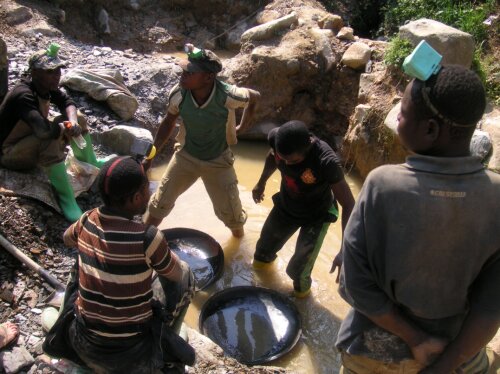
Nik Stoop and Marijke Verpoorten study the mining sector in Eastern DR Congo, with a special focus on interactions between artisanal and industrial mining, and differences across these production modes in terms of linkages with local livelihoods and violence. Co-authors who made contributions to this research project include Sara Geenen, Janvier Kilosho and Peter van der Windt.
Research Questions
- How does artisanal / industrial mining support local livelihoods?
- How does artisanal / industrial mining relate to violence?
- How do artisanal and industrial mining interact, and how do these interactions affect livelihoods and violence?
Research design
We rely on several data sources, that we analyse using both quantitative and qualitative methods:
- Geo-referenced information on the location of artisanal and industrial mining sites from International Peace Information Service (IPIS) and the Congolese Mining Cadastre (CAMI).
- Geo-referenced information on conflict events from the Armed Conflict Location & Event Data Project (ACLED) and from Kivu Security Tracker.
- Semi-structured interviews with stakeholders & focus group discussions with artisanal miners
- Structured interviews with 469 artisanal miners who were ‘illegally’ working in the Kamituga mining site, where Banro - a Canada-based multinational was the legal concession holder.
Some snapshots of our data
-
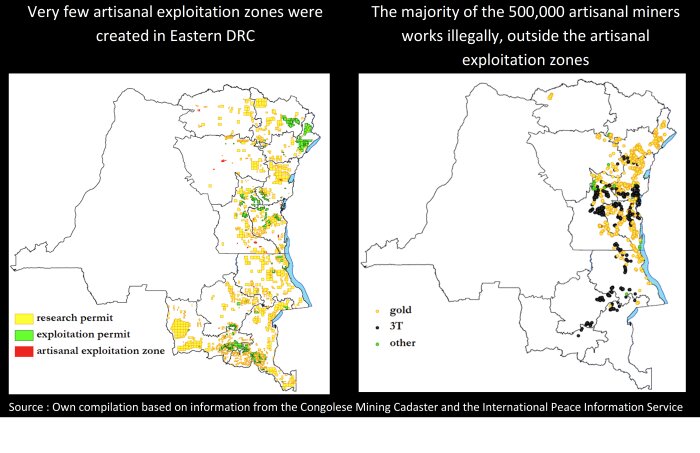 DRC Artisanal Mining
DRC Artisanal Mining -
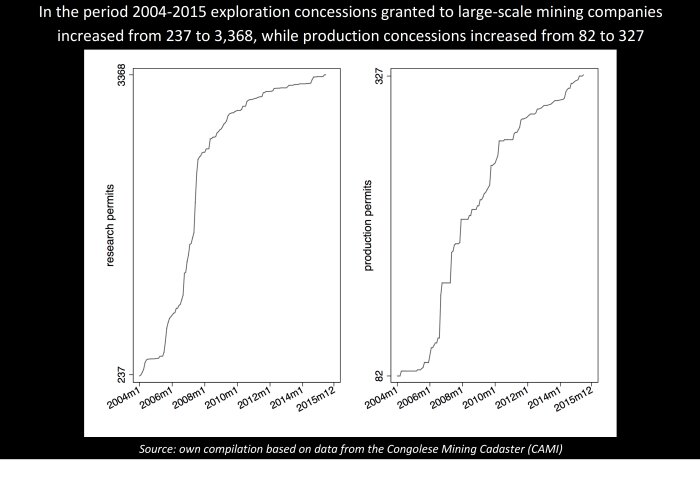 DRC Large-scale Exploration Concessions
DRC Large-scale Exploration Concessions -
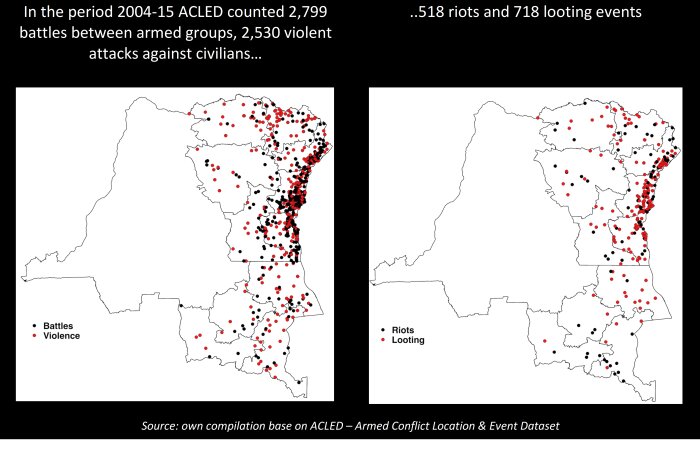 DRC Mining Violence
DRC Mining Violence -
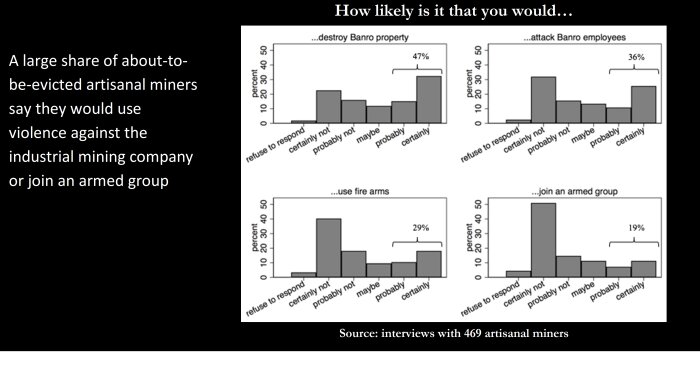 DRC Mining Violence Likelihood
DRC Mining Violence Likelihood
Academic output
Geenen S., Stoop N. and Verpoorten M. (2020). How much do artisanal miners earn? An inquiry among Congolese gold miners (2020) Resources Policy.
Stoop, N. and Verpoorten, M. (2020), Risk, Envy and Magic in the Artisanal Mining Sector of South Kivu, Democratic Republic of Congo. Development and Change.
Stoop N., Verpoorten M. and van der Windt P. (2019). Artisanal or Industrial Conflict Minerals? Evidence from Eastern Congo. World Development 122: 660-674. Replication files are available here.
Stoop N, Verpoorten M, van der Windt P (2018) More legislation, more violence? The impact of Dodd-Frank in the DRC. PLoS ONE 13(8): e0201783. Replication files are available here.
Kilosho B. J., Stoop N. and Verpoorten M. (2017). Defusing the social minefield of gold sites in Kamituga, South Kivu: from legal pluralism to the re-making of institutions? Resources policy 53: 356-368.
Stoop Nik, Kilosho Buraye Janvier, Verpoorten Marijke (2016) Relocation, reorientation, or confrontation? Insights from a representative survey among artisanal miners in Kamituga, South Kivu. Antwerpen, IOB, Institute of Development Policy and Management, University of Antwerp, 55 p
FOR UNGATED PREPRINTS, see Research Gate .
Outreach
We summarized our research findings for a broader audience in eight policy briefs and blogs:
- Artisanal gold mining pays,
- The super-natural is super-rational,
- The way that minerals are mined affects conflict in eastern Congo,
- Artisanal or industrial conflict minerals?,
- More legislation, more violence? The impact of Dodd-Frank in the Democratic Republic of the Congo,
- Trump threatened to suspend the 'conflict minerals' provision of Dodd-Frank : that might actually be good for Congo
- The social minefield of gold digging in South-Kivu, DRC: the case of Kamituga
- The social minefield of gold digging in Kamituga, South-Kivu.
Marijke Verpoorten also gave a Spectrum lecture for the general public, titled “Wiens conflictmineralen? Artisanale versus industriële mijnbouw in DR Congo (12/11/2020).
We presented our work in various academic conferences, seminars and workshops, and organized an academic conference in Bukavu in December 2016, that attracted 150 participants from over 70 different institutions including research institutions (from both the South and North), Congolese ministries, NGOs, think thanks, and private companies.
Research tools, data and replication files
The complete structured survey and all other survey instruments can be accessed below: Kamituga Survey Report; Appendix Kamituga Survey Report
Replication files for the paper Stoop N., Verpoorten M. and van der Windt P. (2019). Artisanal or Industrial Conflict Minerals? Evidence from Eastern Congo. World Development 122: 660-674.
Replication files for the paper Stoop N, Verpoorten M, van der Windt P (2018) More legislation, more violence? The impact of Dodd-Frank in the DRC. PLoS ONE 13(8): e0201783.
Funding
The
research is funded by FWO – Research Foundation Flanders (Research grant
1517614N, PhD scholarship 11Q2816N and EOS Project 30784531), and by CEGEMI –
Centre d'Expertise en Gestion Minière at the Université catholique de Bukavu.
Ethics
Permission
to conduct the research was granted by the University of Antwerp’s Ethics
Committee for the Social Sciences and Humanities (file nr. SHW_15_06), by the
Congolese Ministry of Mines, by SAESSCAM (the Congolese public Service for
Assistance to Artisanal and Small-Scale mining) and by the local authorities in
Kamituga.
(Local) collaborators
This
research would not have been possible without the artisanal miners of Kamituga
who offered their time to be interviewed; the enumerators (Alex
Nyakabasa, Célestin Mukotanyi Munyali, Fortunat, Bamporiki Bisanga, Gabriel
Mugisho Dunia, Isidore Barhanywerha Baderhakuguma, John Kadjunga, Jules Nyunda
Nkuru, Olivier Rubambura Kabuye, Pascal Barhanywanywa, Serge Nyembo Charles and
Teiggy Birhula Mongane) who worked in sometimes challenging circumstances;
the local guides in Kamituga (Belgique Babingwa, Jean Bisimwa, Leonard
Kabungulu, Oswald Bilinganene, Paul Aishi Wabutongo and Waluna Itongwa);
and Janvier Kilosho who contributed to supervising the data collection. We
offer them our sincere gratitude. We further owe thanks to employees of Banro,
SAESSCAM, IPIS (International Peace Information Service) and INSO
(International NGO Safety Organization) for their assistance and for sharing
valuable information and data with us.